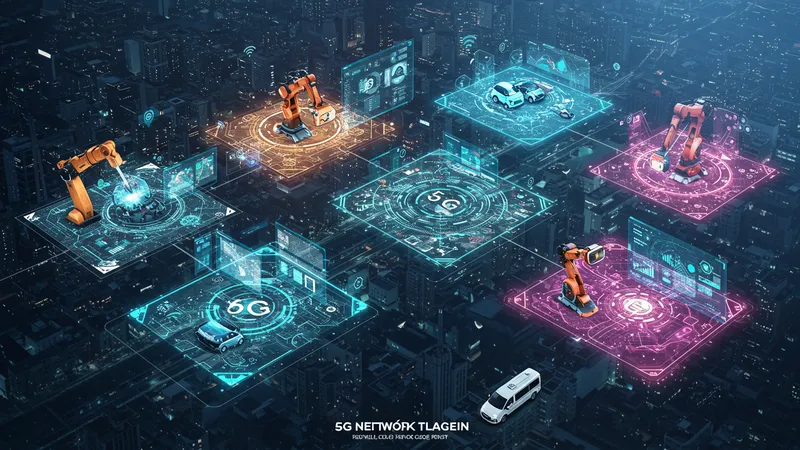

Imagine a network that can instantly adapt to different types of users and services—whether supporting industrial robots, virtual reality, or connected vehicles—without compromising on speed, reliability, or flexibility. This level of agile connectivity is enabled by a strategic approach known as intelligent network slicing management in 5G. Rather than treating the network as a single, monolithic pipe, this method divides it into multiple virtual segments, each customized and optimized for a specific use case or industry requirement.
At its core, intelligent network slicing management leverages advanced orchestration tools and real-time analytics to automatically allocate resources, prioritize traffic, and ensure each segment delivers the ideal balance of throughput, latency, and security. This means service providers can deliver on distinct performance promises for hundreds of different industries and applications—all simultaneously, and with unprecedented efficiency.

The ability to configure dedicated virtual networks for different services is a major leap from previous generations. Network slicing makes it possible to dedicate ultra-reliable, low-latency resources to critical infrastructure while simultaneously supporting high-throughput entertainment or large-scale IoT deployments on the same physical hardware. As a result, industries such as manufacturing, healthcare, and transportation can achieve higher operational efficiency and service differentiation.
Each of the leading platforms—Ericsson, Nokia, and Huawei—has pioneered unique approaches and management tools. Ericsson’s solution stands out for dynamic allocation and its plug-and-play orchestration. Nokia offers strong integration with its end-to-end 5G suite and brings robust automation features. Huawei’s focus is on high-density scalability and seamless integration with diverse legacy systems, making it especially attractive for complex deployments.
Advanced management tools underpin all effective network slicing strategies. Orchestration platforms employ AI-driven analytics to monitor network conditions in real-time and respond instantly to changes in demand or security threats. This keeps each network slice performing optimally, even during congestion or large-scale events, and ensures compliance with service level agreements for customers relying on mission-critical communication.
The competitive landscape is driven by how well these platforms automate decision-making and resource management. Real-world implementations have demonstrated significant improvements in network utilization, average latency reduction, and streamlined onboarding for new industrial services. The next sections explore exactly how these systems operate behind the scenes, and what separates industry leaders from the rest.
These foundational technologies are transforming 5G into a platform for innovation across industries. But what are the secret mechanics that deliver such reliable, flexible performance—especially as demands surge and services diversify? The deeper details reveal even more valuable insights ahead…
Resource allocation is the engine that powers all effective network slicing management. Each network slice often has its own unique requirements—some demand ultra-low latency for mission-critical applications, while others prioritize high bandwidth for media streaming. Intelligent management platforms like Ericsson Dynamic Network Slicing use advanced orchestration algorithms to allocate spectrum, compute, and core network resources precisely where they are needed in real time. This approach eliminates resource wastage and supports tailored service level agreements across all slices of the 5G network.

Dynamic resource allocation not only improves performance, but it also creates better cost-efficiency. For instance, with solutions from Nokia, dormant resources are quickly repurposed for active slices as traffic loads shift. This means providers can maximize the use of their networking infrastructure and adapt effortlessly to fluctuating user and application demands. The automation provided by these solutions minimizes manual intervention and reduces management overhead significantly compared to legacy systems.
Scalability is another factor where intelligent management stands out. Huawei's slicing architecture supports quick and seamless scaling up or down of resources, without requiring changes to underlying hardware. This is ideal for supporting large events or sudden spikes in device connections—such as sporting events with thousands of live video streams or factories deploying hundreds of new sensors.
Insights from recent deployments demonstrate up to a 30% improvement in network utilization rates and more consistent quality of service metrics. The ability to rapidly and automatically fine-tune allocations means businesses can rely on their network slice when it matters most, whether that's in a smart hospital or a connected logistics hub. Understanding exactly how this is achieved sets the stage for uncovering the next layer of 5G performance optimization.
Continuous performance monitoring and analytics are cornerstones of modern network slicing management. Ericsson, Nokia, and Huawei all equip their slicing solutions with live dashboards that track metrics such as throughput, latency, packet loss, and service availability for each slice. This data-rich environment makes it possible to diagnose issues, predict future bottlenecks, and implement proactive optimization before end users notice quality changes.

Unlike legacy systems, intelligent network slicing management leverages machine learning to identify patterns and performance anomalies automatically. For example, if a sudden latency spike emerges in a slice supporting autonomous vehicles, the system can immediately trigger corrective measures—like provisioning extra resources or re-routing traffic. This rapid, automated response is crucial for sectors that rely on real-time communication and safety-critical operations.
These platforms also provide extensive historical analytics, allowing operators to evaluate trends over time and optimize slice configurations for recurring events or industry cycles. With Nokia's integrated toolkit, for instance, businesses can easily generate compliance reports and ensure all contracted service levels are consistently met.
As demands and use cases diversify, the ability to proactively manage slice health and make data-driven decisions becomes a key differentiator. The deeper the insight into performance metrics, the more targeted and effective slice management becomes—fueling future-proof 5G performance. Next, we’ll explore how security and isolation are maintained within complex multi-slice environments.
Security is a critical pillar in intelligent network slicing management. Since each 5G network slice functions like an independent virtual network, robust isolation mechanisms must be in place to prevent cross-traffic or data leakage. All leading platforms—Ericsson, Nokia, and Huawei—integrate encryption and strict access controls so each slice is completely segmented from others, supporting sectors with varying compliance and privacy demands.

Automated threat detection plays an essential role. Real-time monitoring systems scan for abnormal patterns or unauthorized access attempts, enabling network administrators to lockdown affected slices or adjust policies instantly. This agility is especially valuable for organizations handling sensitive data, such as financial services or public safety authorities dependent on uninterrupted, secure communications.
Beyond traditional security, intelligent slicing management introduces role-based access at every orchestration layer. Operators can configure who manages, monitors, or modifies which slice, reducing the risk of accidental misconfiguration or malicious activity from within the network operation center itself.
The synergy of physical and virtual security controls means organizations can safely deliver specialized services and maintain regulatory compliance with evolving industry standards. The ability to consistently isolate and protect numerous, concurrent slices underpins trust in next-generation 5G services. The final component—automation for lifecycle management—brings all these capabilities together for continuous improvement.
Automation is the glue that ensures 5G network slicing management operates at scale with minimal manual intervention. Sophisticated orchestration tools from Ericsson, Nokia, and Huawei facilitate the full lifecycle of a slice—from initial design and deployment to ongoing monitoring and decommissioning. This dramatically accelerates time-to-market for new services and enables organizations to quickly adapt to evolving network needs.

Lifecycle management encompasses everything from slice instantiation and scaling to dynamic policy updates and auditing. For example, Nokia’s suite allows network operators to programmatically adjust traffic policing or quality of service limits as demand shifts—without disrupting running services. This agility supports continuous service innovation and cost optimization.
The use of AI-powered automation reduces operational complexity and frees personnel to focus on business-critical initiatives rather than routine configuration tasks. Lessons from real-world deployments show that automation can cut service rollout times by more than half, speed up upgrades, and reduce the risk of human error across highly dynamic network environments.
In summary, intelligent network slicing management is reshaping the landscape of 5G performance. The strategic fusion of real-time resource allocation, analytics, security, and automation empowers networks to deliver truly differentiated, resilient, and future-ready services for every industry. These advanced capabilities are not just transformative—they are essential for realizing the full vision of 5G as the backbone of next-generation digital infrastructure.